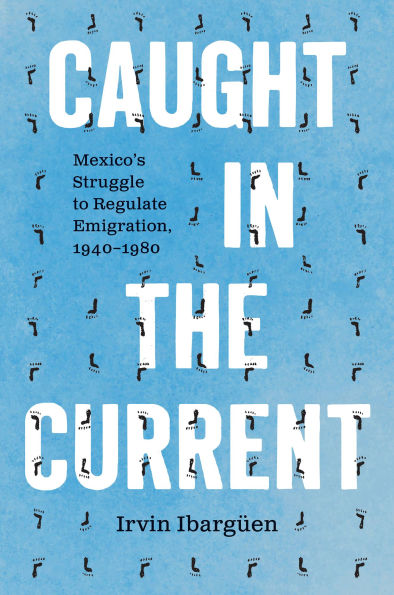Migration between the United States and Mexico is often compared to the river that runs along the border: a “flow” of immigrants, a “flood” of documented and undocumented workers, a “dam” that has broken. Scholars, journalists, and novelists often tell this story from a south-to-north perspective, emphasizing Mexican migration to the United States, and the American response to the influx of people crossing its borders.
In Caught in the Current, Irvin Ibargüen offers a Mexico-centered history of migration in the mid-twentieth century. Drawing on Mexican periodicals and archival sources, he explores how the Mexican state sought to manage US-bound migration. Ibargüen examines Mexico’s efforts to blunt migration’s impact on its economy, social order, and reputation, at times even aiming to restrict the flow of migrants. As a transnational history, the book highlights how Mexico’s policies to moderate out-migration were contested by both the United States and migrants themselves, dooming them to fail. Ultimately, Caught in the Current reveals how both countries manipulated the border to impose control over a phenomenon that quickly escaped legal and political boundaries.
1147183464
In Caught in the Current, Irvin Ibargüen offers a Mexico-centered history of migration in the mid-twentieth century. Drawing on Mexican periodicals and archival sources, he explores how the Mexican state sought to manage US-bound migration. Ibargüen examines Mexico’s efforts to blunt migration’s impact on its economy, social order, and reputation, at times even aiming to restrict the flow of migrants. As a transnational history, the book highlights how Mexico’s policies to moderate out-migration were contested by both the United States and migrants themselves, dooming them to fail. Ultimately, Caught in the Current reveals how both countries manipulated the border to impose control over a phenomenon that quickly escaped legal and political boundaries.
Caught in the Current: Mexico's Struggle to Regulate Emigration, 1940-1980
Migration between the United States and Mexico is often compared to the river that runs along the border: a “flow” of immigrants, a “flood” of documented and undocumented workers, a “dam” that has broken. Scholars, journalists, and novelists often tell this story from a south-to-north perspective, emphasizing Mexican migration to the United States, and the American response to the influx of people crossing its borders.
In Caught in the Current, Irvin Ibargüen offers a Mexico-centered history of migration in the mid-twentieth century. Drawing on Mexican periodicals and archival sources, he explores how the Mexican state sought to manage US-bound migration. Ibargüen examines Mexico’s efforts to blunt migration’s impact on its economy, social order, and reputation, at times even aiming to restrict the flow of migrants. As a transnational history, the book highlights how Mexico’s policies to moderate out-migration were contested by both the United States and migrants themselves, dooming them to fail. Ultimately, Caught in the Current reveals how both countries manipulated the border to impose control over a phenomenon that quickly escaped legal and political boundaries.
In Caught in the Current, Irvin Ibargüen offers a Mexico-centered history of migration in the mid-twentieth century. Drawing on Mexican periodicals and archival sources, he explores how the Mexican state sought to manage US-bound migration. Ibargüen examines Mexico’s efforts to blunt migration’s impact on its economy, social order, and reputation, at times even aiming to restrict the flow of migrants. As a transnational history, the book highlights how Mexico’s policies to moderate out-migration were contested by both the United States and migrants themselves, dooming them to fail. Ultimately, Caught in the Current reveals how both countries manipulated the border to impose control over a phenomenon that quickly escaped legal and political boundaries.
27.95
Pre Order
5
1

Caught in the Current: Mexico's Struggle to Regulate Emigration, 1940-1980
272
Caught in the Current: Mexico's Struggle to Regulate Emigration, 1940-1980
272
27.95
Pre Order

Product Details
| ISBN-13: | 9781469689586 |
|---|---|
| Publisher: | The University of North Carolina Press |
| Publication date: | 10/07/2025 |
| Series: | The David J. Weber Series in the New Borderlands History |
| Pages: | 272 |
| Product dimensions: | 6.12(w) x 9.25(h) x 1.00(d) |
About the Author
What People are Saying About This
From the B&N Reads Blog
